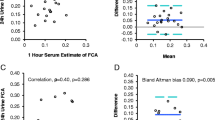Summary
Enteral absorption of iron was determined in 15 patients with chronic renal insufficiency, who are kept on maintenance haemodialysis, after oral application of a single dose of59Fe. A liquid scintillation whole body counter was used for these measurements. The results were compared with those observed in a group of 12 healthy control subjects. It was found that measurements 3 to 4 days after ingestion of59Fe gave significantly higher results than after two weeks (p<0.01 for controls,p<0.001 for patients). It is evident that the 2-weeks value represents true iron absorption. The patients studied exhibited significantly lower reabsorption of iron (geometric mean 4.0% of dose) than the controls (geometric mean 8.8% of dose;p<0.05). Even patients with decreased or no iron stores in the bone marrow showed no increase in iron reabsorption. Conflicting results reported in the literature as to this topic are discussed. An estimate of the iron requirement of patients on maintenance haemodialysis reveals an iron deficit of at least 0.5 g/year requiring adequate replacement therapy.
Zusammenfassung
Die enterale Eisenresorption wurde nach Applikation einer oralen Einzeldosis von59Fe mit Hilfe eines liquid scintillation Ganzkörperzählers bei fünfzehn Patienten mit chronischer Niereninsuffizienz unter Langzeitdialyse-Behandlung gemessen und mit einer Kontrollgruppe gesunder Probanden verglichen. Es zeigte sich, daß die nach drei bis vier Tagen verbleibende Radioaktivität nicht der effektiv absorbierten Eisenmenge entspricht und sich signifikant (p<0,01 für Kontrollen,p<0,001 für Patienten) von der 14-Tage-Aktivität unterscheidet. Letztere entspricht der tatsächlichen Eisenresorption. Bei den untersuchten Dialyse-Patienten fand sich durchwegs eine niedere Resorption (geometrisches Mittel 4,0% der verabreichten Dosis), welche sich signifikant (p<0,05) von der Resorption gesunder Kontrollpersonen unterschied (geometrisches Mittel 8,8% der verabreichten Dosis). Auch Patienten, welche im Knochenmark verminderte oder fehlende Eisenspeicher aufwiesen, zeigten keine Steigerung der Eisenresorption. Widersprüchliche Ergebnisse in der Literatur hinsichtlich dieses Befundes werden diskutiert. Eine überschlagsmäßige Berechnung des Eisenbedarfes der Dialyse-Patienten ergibt, daß pro Jahr wenigstens mit einem Eisendefizit von 0,5 g zu rechnen ist, welches durch medikamentöse Zufuhr ersetzt werden muß.
Similar content being viewed by others
Literatur
Bainton, D. F., Finch, C. A.: The diagnosis of iron deficiency anemia. Amer. J. Med.37, 62–70 (1964).
Blumberg, A.: Unveröffentlichte Ergebnisse.
Boddy, K., Lawson, D. H., Linton, A. L., Will, G.: Iron metabolism in patients with chronic renal failure. Clin. Sci.39, 115–121 (1970).
Callender, S. T.: Digestive absorption of iron. In: Iron metabolism, an International Symposium, p. 89. Berlin-Göttingen-Heidelberg-New York: Springer 1964.
Carter, R. A., Hawkins, J. B., Robinson, B. H.: Iron metabolism in the anaemia of chronic renal failure. Effects of dialysis and of parenteral iron. Brit. med. J.1969 III, 206–210.
Cook, J. D., Layrisse, M., Finch, C. A.: The measurement of iron absorption. Blood33, 421–429 (1969).
Comty, C. M., McDade, D., Kaye, M.: Anemia and iron requirements of patients treated by maintenance hemodialysis. Trans. Amer. Soc. artif. intern. Org.14, 426–433 (1968).
Curtis, J. R., Eastwood, J. B., Smith, E. K., Storey, J. M., Verroust, P. J., Wardener, J. E. de, Wing, A. J., Wolfson, E. M.: Maintenance haemodialysis. Quart. J. Med.38, 50–89 (1969).
Donath, A.: Persönliche Mitteilung.
Eschbach, J. W., Funk, D., Adamson, J., Kuhn, I., Scribner, B. H., Finch, C. A.: Erythropoesis in patients with renal failure undergoing chronic dialysis. New Engl. J. Med.276, 653–658 (1967).
—— Cook, J. D., Finch, C. A.: Iron absorption in chronic renal disease. Clin. Sci.38, 191–196 (1970).
Evans, D. B., Clarkson, E. M., Curtis, I. R.: Blood loss using the modified two layer Kiil dialyzer. Brit. med. J.1967 II, 651–653.
Gale, E., Torrance, J., Bothwell, T.: The quantitative estimation of total irons tores in human bone marrow. J. clin. Invest.42, 1076–1082 (1963).
Gral, T., Lederer, M., Gerszi, K. E., Rubini, M. E.: Iron transfer from dialysate to patient during chronic dialysis Nephron6, 537–541 (1969).
Hausmann, K., Kuse, R., Sonnenberg, O. W., Bartels, H., Heinrich, H. C.: Interrelations between iron stores, general factors and intestinal iron absorption. Acta haemat. (Basel)42, 193 (1969).
Hawkins, J.B., Carter, R.A., Philip, H., Robinson, B.H.B.: Iron retention and utilization in chronic uraemia. 4th Internat. Congr. Nephrol., Stockholm 1969.
Heinrich, H. C., Bartels, H., Gabbe, E. E., Meinecke, B., Nass, W. P., Whang, D. H.: Die intestinale Resorption des Nahrungs-Eisens aus dem Hämoglobin, der Leber und Muskulatur bei Menschen mit normalen Eisenreserven und Personen mit prälatentem/latentem Eisenmangel. Klin. Wschr.47, 309–317 (1969).
Höglund, S., Reizenstein, P.: Studies in iron absorption, IV. Effect of humoral factors on iron absorption. Blood34, 488–495 (1969).
—— Studies in iron absorption IV. Transitory effect of oral administration of iron on iron absorption. Blood34, 505–510 (1969).
Kuhn, I. N., Monsen, E. R., Cook, J. D., Finch, C. A.: Iron absorption in man. J. Lab. clin. Med.71, 715–721 (1968).
Lauber, K.: Bestimmung von Serumeisen und Eisenbindungskapazität ohne Enteiweißung. Z. klin. Chem.3, 96 (1965).
Layrisse, M., Cook, J. D., Martinez, C., Roche, M., Kuhn, I. N., Walker, R. B., Finch, C. A.: Food iron absorption: a comparisson of vegetable and animal foods. Blood33, 430–443 (1969).
Moore, C. V.: Iron nutrition. In: Iron metabolism, an internat. Symposium, p. 241. Berlin-Göttingen-Heidelberg-New York: Springer 1964.
Nixon, R. K., Olson, J. P.: Diagnostic value of marrow hemosiderin patterns. Ann. intern. Med.69, 1249–1254 (1968).
Wright, F. K., Goldsmith, H. J., Hall, S. M.: Iron responsive anemia in repeated dialysis treatment without routine blood transfussion. Proc. Europ. Dial. Transpl. Ass.5, 179–183 (1968).
Zilva, J. F., Patston, V. J.: Variations in serum-iron in healthy women. Lancet1966 I, 459–462.
Sulin, A., Blumberg, A.: Unveröffentlichte Ergebnisse.
Author information
Authors and Affiliations
Rights and permissions
About this article
Cite this article
Blumberg, A., Chappuis, C. Die enterale Eisenresorption bei der chronischen Niereninsuffizienz unter Langzeitdialyse-Behandlung. Klin Wochenschr 49, 41–46 (1971). https://doi.org/10.1007/BF01494065
Issue Date:
DOI: https://doi.org/10.1007/BF01494065




